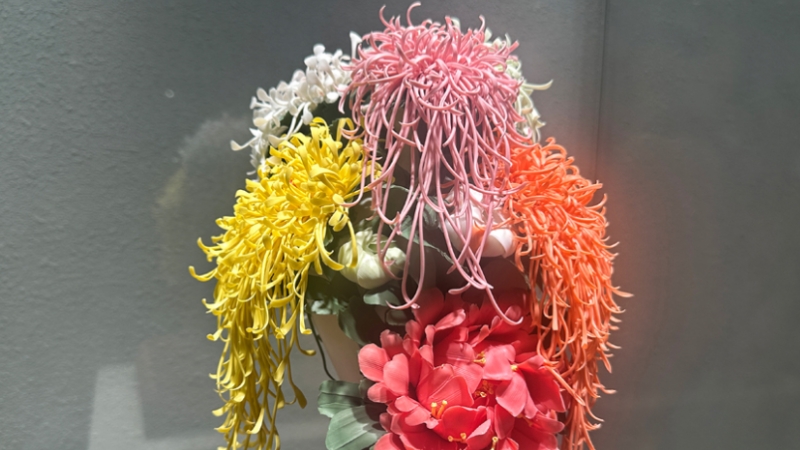East China county graced, empowered by Hanfu
JINAN, Dec. 21 (Xinhua) -- Wang Bo was not really a fan of costume dramas. It was a big decision for the 26-year-old farmer in east China's Shandong Province to close his chicken farm in 2015 and revert to producing traditional Chinese dress, also known as Hanfu.
But this business turned out to be unexpectedly successful.
Wang now owns a small workshop employing more than 20 workers, with revenue last year exceeding eight million yuan (about 1.13 million U.S. dollars).
"In the Ancailou Township where I live, almost all the young people born after 1995 are now involved in Hanfu businesses," he said.
In recent years, benefiting from the growing popularity of social media and a craze for traditional culture, Hanfu, a traditional style of clothing worn by the Han people which usually features intricate embroidery, was returned to the spotlight by a new wave of young Chinese devotees.
However, few people know that the biggest Hanfu producing base in China is Caoxian County, which administers Ancailou. In the first nine months this year, sales of Hanfu in the county reached a record high of 5.53 billion yuan, a year-on-year increase of 45.22 percent. About 40 percent of the total Hanfu in China's domestic market was produced in Caoxian.
According to Zhang Longfei, director of Caoxian's e-commerce service center, the county with more than 1.3 million people is one of Shandong's most populous counties, and used to be the origin of many migrant workers who left the region to pursue jobs in China's big cities.
About 15 years ago, some villagers in this county tested the waters by making Hanfu costumes for photo studios and performances, before also hustling around to try to sell them.
The situation was changed by the rise of e-commerce in China. In 2009, these Hanfu makers opened online stores, and found that their dresses sold surprisingly well.
In the following years, more villagers joined the Hanfu business, involved in either production or online sales. "Selling on Taobao is better than rushing about" became a slogan in Caoxian.
Wang from Ancailou had been a migrant worker before 2014, earning 2,000 to 3,000 yuan a month. Seeing the booming Hanfu industry in his hometown, he decided to return there. In the first month, he earned more than 200,000 yuan.
Over the past few years he witnessed a production chain taking shape in Caoxian.
University graduate Liang Li returned in spring this year. An art major, the 25-year-old became a designer of Hanfu, earning about 8,000 yuan a month.
Guo Peng, from central China's Henan Province, used to be involved in a clothing business in the south Chinese city of Guangzhou, before opening a store in Caoxian last year. "Last November my store opened along with six others," he recalled. "Now we have more than 70 clothing stores nearby."
"Find a designer on the internet. After you've got the design, you can find everything you need here, from fabrics to accessories, to produce the costumes," said Li Wenchuang, who, like Wang, returned to Caoxian to start his own Hanfu company in 2017.
This industrial agglomeration has driven down the cost of Hanfu, which used to cost about 1,000 yuan per item. Now Hanfu items produced in Caoxian are sold for only between 100 yuan and 300 yuan each, which is easily affordable for more young people, even students.
Caoxian County is currently home to 12,797 online Hanfu stores and 2,186 companies related to the business, while close to 100,000 people are involved in the Hanfu industry.
According to research firm iMedia Research, the value of the Hanfu market in China was estimated at 12.54 billion yuan in 2022, and it will likely rise to 19.11 billion yuan in 2025.
To encourage the development of Hanfu businesses, the local government of Caoxian County earmarked about 10 billion yuan to build an industrial park, while a Hanfu association was established to promote collaboration between producers, designers and colleges.
At the same time, a center for safeguarding of intellectual property rights was set up in the county, reducing the number of days needed for patent application processing from 180 to 10 days.
Hao Chaoliang, an official with the Ancailou Township, expressed hope that the Hanfu produced in Caoxian could be promoted to more places across China, a pursuit for which offline stores are a good option.
Thanks to her offline store, which was the first in Ancailou, Bai Menghan has already received orders from tourist cities such as Xi'an of northwest China's Shaanxi Province and Luoyang in Henan. She is now planning to open stores in Shanghai, Xi'an and Zhengzhou.
For his part, Wang Bo is trying to complete the production line in his workshop. "I can do everything now except printing," he said. "So the cost of my clothes is about 15 to 20 percent lower than others. In the future I am going to focus on high quality."
Photos
Related Stories
- Caoxian county in E China's Shandong spearheads Hanfu industry development
- 26th China (Hainan) Int'l Tropical Agricultural Products Winter Trade Fair kicks off
- TikTok e-commerce returns to Indonesia by merging with Tokopedia
- China's e-commerce logistics index up in November
- China's cross-border e-commerce thrives, delivering global dividends
Copyright © 2023 People's Daily Online. All Rights Reserved.









